Results 6,131 to 6,140 of 12096
Thread: Anandtech News
-
07-15-16, 07:49 AM #6131
Anandtech: Spot The Denverton: Atom C3000 Silicon On Display
There are a few news items from Computex we didn’t cover at the time that I want to visit. The first is Denverton, and how one manufacturer had a relevant beta motherboard on display during the show. Denverton is the successor to Avoton, Intel’s 8-core Atom processor that we’ve seen in the ASRock C2750D4I and other and a variety of NAS and server based ‘card’ solutions (GIGABYTE showed a 46x C2750 server in 2U back at Computex in 2015). Avoton uses eight Bay Trail based cores, while Denverton will use the upgraded Cherry Trail microarchitecture design.
The Denverton based motherboard on show was an ‘early’ sample, offering four DDR4 slots supporting RDIMMs, four SATA breakout ports (for 16 SATA drives, sharing some SoC PCIe lanes), dual 10G SFP+ ports, dual gigabit network ports (via Intel I210), 32GB of eMMC and an Aspeed AST2400 board management controller. A single PCIe 3.0 x8 slot is provided for additional functionality.
The chip at the center of this, after we asked nicely for the heatsink to be removed, is a 1.8 GHz Denverton part built on Intel’s 14nm process using the Airmont microarchitecture. The QKP2 code is not yet public it seems, however we were told to expect this board in a 4-to-16 core design within similar power envelopes as the previous generation. Denverton is the 14nm die shrink of Avoton, so single core performance is expected to be within a few percent but the main advantages of the die shrink will be power consumption per core.
IDF is currently set for mid-August, and we will have at least a trio of editors there for the ride. At this point in development, we are likely to see some announcements being made towards the Denverton platform. If there is a full release at that time, we should see full specification sheets and pricing. Failing IDF, Supercomputing16 is in November.Microarchitecture Node Release Main SoC Name Server Codename Goldmont 14nm 2016 Apollo Lake ? Airmont 14nm 2014 Cherry Trail Denverton Silvermont 22nm 2013 Bay Trail Avoton Saltwell 32nm 2011 Clover Trail
Cedar TrailCenterton
Briarwood
Gallery: Spot The Denverton: Atom C3000 Silicon On Display





More...
-
07-15-16, 09:38 AM #6132
Anandtech: More Atom: Apollo Lake On Display
Further to our recent post about spotting Denverton silicon on display at Computex this year, we also caught an Apollo Lake mini-PC motherboard doing the rounds at the ECS booth. The mini-PC line from ECS incorporates many versions of the Liva, which run the gamut from dual core Atom all the way up to Core-M and Core i3, depending on how much power you need or how much you want to spend. Ganesh has in recent months reviewed the LIVA One with Skylake, the LIVA Core with Core-M, the LIVA x2 with Braswell and the LIVA X with Bay Trail-M. Based on that naming scheme, the motherboard we saw at Computex from ECS stands to be something like the LIVA x3.
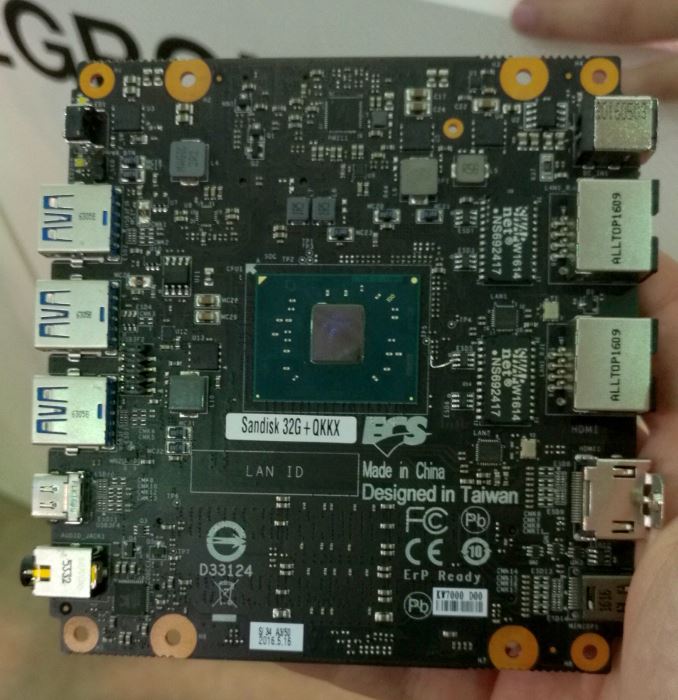
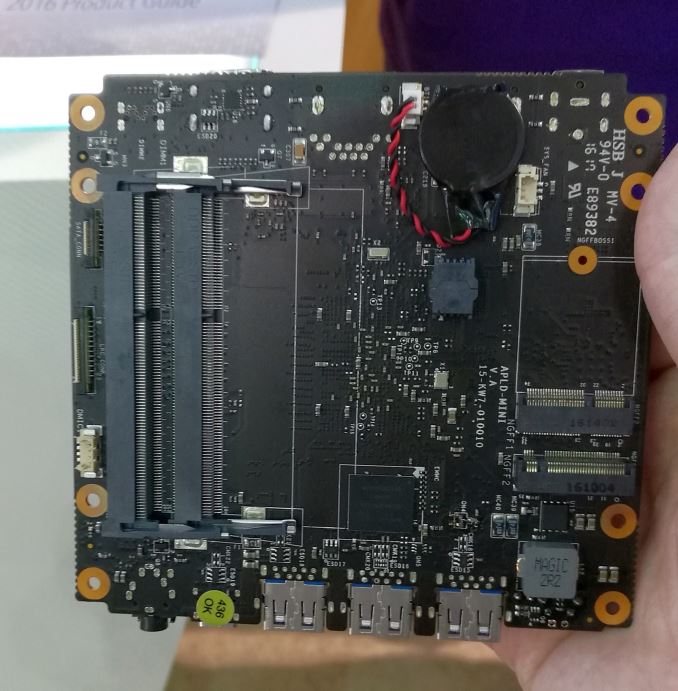

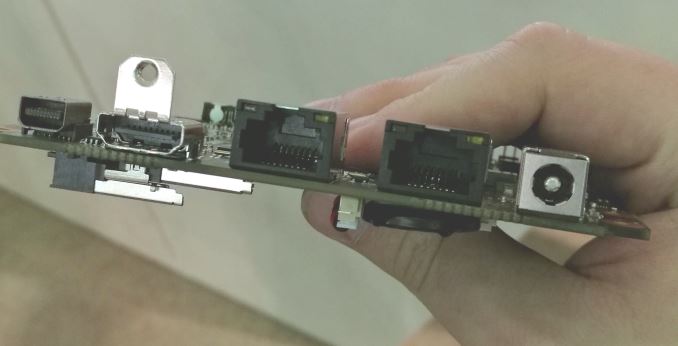
Apollo Lake uses Intel’s latest Atom cores, based on the Goldmont microarchitecture. We reported on Broxton for smartphones and tablets, also based on Goldmont, being canned earlier this year however the microarchitecture will live on in notebooks and mini-PCs for 2016 and 2017 (with servers/embedded even later). This motherboard shows an unknown Apollo Lake die, measuring in at 159.7 mm2 (11.24 x 9.98 mm), with DC-In power, dual network ports, three USB 3.0 Type-A ports, one USB 3.0 Type-C port, a HDMI output, a mini-DP output, two SO-DIMM slots and dual M.2: one for WiFi and one for storage.
We reported on Apollo Lake being unveiled at IDF Shenzhen back in April, with up to four cores and Intel’s Gen9 graphics with an unknown amount of execution units. Apollo Lake supports DDR3L as well as LPDDR3/4, eMMC for storage, soldered down 802.11ac Intel WiFi and improved PMIC (power management) options. One of the headlines from the IDF Shenzhen presentation was the reduction in bill of materials cost (BOM) for the OEMs, up to $7, compared to the previous generation.Comparison of Intel's Entry-Level PC and Tablet Platforms Bay Trail Braswell Cherry Trail Apollo Lake Microarchitecture Silvermont Airmont Airmont Goldmont Core Count Up to 4 Graphics uArch Gen 7 Gen8 Gen8 Gen9 EU Count unknown 16 12/16 unknown (24?) Multimedia
CodecsMPEG-2
MPEG-4 AVC
VC-1
WMV9
HEVC (SW only)
VP9 (SW only)MPEG-2
MPEG-4 AVC
VC-1
WMV9
HEVC (8-bit software/hybrid)
VP9 (software/hybrid)MPEG-2
MPEG-4 AVC
VC-1
WMV9
HEVC
VP9Process Technology 22 nm 14 nm 14 nm 14 nm Launch Q1 2014 H1 2015 2015 H2 2016
Along with a new ‘cloudbook’ category (i.e. Chromebook-style), Intel expects Apollo Lake to be in notebooks, all-in-ones and mini-PCs similar to ECS’ design. ECS also had a number of mini-STX designs on display, along with a couple of Intel engineers with some alternative combination mini-PC configurations.
Gallery: More Atom: Apollo Lake On Display





More...
-
07-15-16, 02:13 PM #6133
Anandtech: Zalman ZM-K650WP: Because You Need a Soda-proof, Chip-proof $30 Membrane K
In the land of gaming keyboards and enthusiasts, mechanical keys are easily becoming the norm with every keyboard company coming out with a new feature, doodad, or eSports team sponsorship in a highly competitive market. Without the right guidance and knowledge, it can be difficult to separate the market, and users ultimately end up emotionally invested in their expensive products they use every day. But then you spill a soda on it, or in my case a cup of tea, because you weren’t looking. The keys are now sticky, and the mechanisms don’t feel the same, if you can bare to touch them at all. You look through online guides on how to clean the board, using an array of harsh solvents and cotton buds (or Q-tips) to bring it back to new. Zalman has an alternative up its sleeve.
So it’s not a mechanical keyboard, and relies on standard membrane keys found in the $10 eBay models you can buy. But this keyboard is sealed and designed to be waterproof to the point that you could happily use it underwater. At Computex, Zalman had a hands-on display of the keyboard being used in a large tub of water, and subsequent videos have been posted online showing it in use with a running tap over the top. Add in some chip fragments from your favorite mix of Doritos and Mountain Dew, and when it gets to the point of un-usability (which, to be honest going by some office keyboards, involves fungus), grab some dish soap and a sponge. Five minutes later, it should, with some elbow grease, be back to normal. To be honest, an office environment might be a great place for a washable keyboard.
You can imagine the PC gaming market in several different segments, some of which overlap: those who just want to play, those who want the best equipment, those who attend LAN events, and those that drink at LAN events. Something like a soda-proof, chip-proof cheap keyboard makes sense, such that no-one else will want to steal it and it doesn’t matter what gets dropped on it if it can be easily cleaned. Sure, membrane keys aren’t gaming focused, but if the lack of mechanical keys is what is stopping the user from enjoying the game, then there’s not much else to say.
The ZM-K650WP should be coming to the market sometime in August, with a $30 MSRP. After my meeting at Computex they’ve ended up sending both Tracy and I a couple of samples each, so we’ll get to a review (as much as is possible with a membrane keyboard, perhaps a couple of fun videos) in due course.
Gallery: Zalman ZM-K650WP: Because You Need a Soda-proof, Chip-proof $30 Membrane Keyboard



More...
-
07-15-16, 02:54 PM #6134
Anandtech: Intel Readies New NUCs Based on Kaby Lake and Apollo Lake SoCs
As one might expect, Intel is working on a new generation of its NUC small-form-factor systems based on the company’s upcoming Kaby Lake and Apollo Lake microprocessors. The writers over at FanlessTech have published what appears to be an exclusive of a set of Intel slides regarding the next generation of NUCs, and we are in the process of double verifying the details. Until then, here's our analysis of the news.
The new systems are expected to hit the market in late 2016 and early 2017 and bring a number of new technologies, which are absent from today’s SFF PCs. In particular, the new systems will support Thunderbolt 3, USB 3.1 (10 Gbps), HDMI 2.0 and the new processors.
The upcoming Intel NUC systems are code-named Baby Canyon and Arches Canyon, according to the slides published by FanlessTech. The Baby Canyon PCs will be powered by Intel’s upcoming Kaby Lake-U SoCs, whereas the Arches Canyon will feature the company’s Apollo Lake chips. The new systems will complement and then eventually replace current-gen NUCs running Broadwell, Braswell and Skylake processors. Meanwhile, Intel’s top-of-the-range code-named Skull Canyon NUCfeaturing the high-end Core i7-6700HQ processor (quad-core with Hyper-Threading, 6 MB LLC, Intel Iris Pro Graphics 580 with 72 EUs and eDRAM, etc.) will not be replaced at least until late 2017.
Baby Canyon with Kaby Lake-U SoCs
Intel’s Baby Canyon NUCs will be the positioned as Intel’s mainstream SFF PCs for users, who would like to have Core-based CPUs powered by the company’s high-performance microarchitecture (Kaby Lake in this case). Thanks to microarchitectural enhancements, the new systems promise to be faster than existing mainstream NUCs, but at this point we have no idea what to expect from Kaby Lake in general, except natural enhancements of iGPU as well as improvements to media playback capabilities.
All of the Baby Canyon PCs will support up to 32 GB of DDR4-2133 memory, HDMI 2.0, an M.2-2280 socket for PCIe 3.0 x4 SSDs, a MicroSDXC card-reader as well as a soldered-down Intel Wireless-AC 8265 controller. The Core i7 and i5 Baby Canyon systems will also come equipped with a Thunderbolt 3 controller, which will automatically bring support for USB 3.1 running at up to 10 Gbps, whereas NUCs featuring Core i3 CPUs will continue to rely on USB 3.1 Gen 1 implementation with 5 Gbps transfer-rate. Given all the hubbub surrounding Type-C audio, Intel decided to keep the good-old 3.5 mm audio jack but did not implement support for USB-C Audio into the Baby Canyon, at least, according to the published slides.
The Baby Canyon family of NUCs is projected to arrive in early 2017, around the same time we expect Intel to start discussing its Kaby Lake-U processors with HDMI 2.0 support. Keep in mind that Intel has not announced Kaby Lake chips officially, hence, all the plans are subject change.Intel Baby Canyon NUC PCs NUC7i7BNH NUC7i5BNH NUC7i5BNK NUC7i3BNH NUC7i3BNK CPU Core i7-7000U
Two Cores
28 W TDPCore i5-7000U
Two Cores
15 W TDPCore i3-7000U
Two Cores
15 W TDPGraphics Iris Graphics HD Graphics PCH Intel's next-generation PCH located in CPU package Memory Two SO-DIMM slots, up to 32 GB of DDR4-2133 2.5" bay One 2.5"/9.5 mm bay, SATA3 None 1 x SATA3 None M.2 Slot Up to M.2-2280 SSD with SATA3 or PCIe 3.0 x4 interface Wi-Fi/BT Soldered-down Intel Wireless-AC 8265 (802.11ac 2x2 + BT 4.2) with WiDi support Ethernet Intel I219V Gigabit Ethernet controller Display Outputs DisplayPort 1.2 via USB-C connector
HDMI 2.0Audio 3.5 mm TRRS audio jack
7.1 channel audio output via HDMI or DPThunderbolt One Thunderbolt 3 (40 Gbps) None USB-C 1 x USB 3.1 (10 Gbps) 1 x USB 3.0 (5 Gbps) USB 4 USB 3.0 Type-A (5 Gbps), one with charging Other I/O MicroSDXC card reader with UHS-I support
One infrared receiverSize (mm) 115 × 111 × 51 115 × 111 × 31 115 × 111 × 51 115 × 111 × 31 PSU External, 65 W OS Compatible with Windows 7/8.1/10
Arches Canyon NUCs with Apollo Lake SoCs
The Arches Canyon NUCs will be Intel’s new entry-level SFF systems running Apollo Lake SoCs branded as Celeron J-series processors. The chips will feature all new Goldmont x86 microarchitecture, Intel’s ninth-generation graphics architecture (Gen9) as well as improved media playback (due to hardware-accelerated playback of 4K video encoded using HEVC and VP9 codecs). Since the new SoCs are rated for 10 W TDP, it is logical to expect higher clock speeds than previous Atom-based NUCs, even though at this point this is a speculation.
Intel reportedly plans to offer two versions of its Arches Canyon NUCs: the NUC6CAYS with 2 GB of DDR3L-1866 memory, 32 GB eMMC storage and pre-installed Windows 10 Home x64 OS; as well as the NUC6CAYH, which will come as a barebone PC. Both systems will still support up to 8 GB of DDR3L memory, one 2.5”/9.5 mm SSD/HDD, a 1x1 wireless module supporting IEEE 802.11ac Wi-Fi and Bluetooth 4.2, an HDMI 2.0 display output, USB Type-A ports, an SDXC card reader and so on. Intel decided to place a D-Sub connector on the back to enable connectivity with cheap displays.
Based on the documents published by FanlessTech, the fully-populated NUC6CAYS will hit the market ahead of the barebone NUC6CAYH sometimes in the fourth quarter of this year.Intel Arches Canyon NUC PCs NUC6CAYS NUC6CAYH CPU Intel Celeron J-series
Four Cores
10 W TDPGraphics HD Graphics PCH Integrated into CPU Memory 2 GB DDR3L-1866 pre-installed
Two SO-DIMM slots,
up to 8 GB of DDR3L-1866-
Two SO-DIMM slots,
up to 8 GB of DDR3L-1866On-Board Storage 32 GB eMMC None 2.5" bay One 2.5"/9.5 mm bay, SATA3 M.2 Slot None Wi-Fi/BT Intel Wireless-AC 316x (802.11ac 1x1 + BT 4.2) M.2-2230 card with WiDi support Ethernet Intel Gigabit Ethernet controller Display Outputs D-Sub
HDMI 2.0Audio 3.5 mm TRRS audio jack
TOSLINK
7.1 channel audio output via HDMIThunderbolt None USB 4 USB 3.0 Type-A (5 Gbps), one with charging Other I/O SDXC card reader with UHS-I support Dimensions 115 × 111 × 51 mm PSU External, 65 W OS Pre-installed Microsoft Windows 10 Home x64 with Intel Remote Keyboard Compatible with Windows 7/8.1/10
Please keep in mind that all the information regarding Intel’s new generations of NUCs is completely unofficial and many details may change by the time the systems hit the market. Intel responded to requests for confirmation and responded with 'Intel does not comment on unreleased products', which is the expected response. As mentioned at the top of this news, we are in the process of double verifying the information in the slides, but for anyone who follows Intel's NUC lines, these hardware specifications are not far fetched at all and make sense for the markets they are entering.
Gallery: Intel Readies New NUCs Based on Kaby Lake and Apollo Lake SoCs


More...
-
07-18-16, 03:38 AM #6135
Anandtech: Softbank Acquires ARM in 24B GBP Deal
While we normally focus on the technology, to have a holistic understanding of the industry it’s necessary to see the business side as well. While ARM has been an independent company for some time now, today Softbank has leveraged the fall in the value of the British Pound to buy ARM Holdings plc, the company responsible for the ARM ISA, ARM Cortex CPUs and MCUs, Mali GPUs, and numerous other IP blocks that are often used in SoCs today. If you’ve followed our coverage, this isn’t really a surprise, but Softbank is primarily a telecom and internet-centric company with relatively little focus on CMOS chip design.
ARM is valued at 11.89 GBP per share, so to be bought out at 17 GBP per share is a fairly significant premium above the market rate. Looking at past investments it seems that Softbank is no stranger to these kinds of plays but it’s not clear whether Softbank will take a hands-on approach to managing the company or mostly leave ARM to its devices. One option is that they favor a more hands-off approach and ARM is primarily a financial investment for Softbank. It remains to be seen what kind of effect this will have, but the financial backing of a major Japanese conglomerate would likely allow for ARM to devote additional time and resources to designing new architectures to better target high performance mobile and server applications which could impact the industry significantly to ARM’s benefit.
The other option is if Softbank takes a much more hands-on approach to managing ARM, which could be interesting if it helps root out whatever normalized deviance exists in management or engineering at ARM, but could also completely destroy the company if a poor approach is taken. Of course, there’s no way to know what path Softbank will take here, but regardless it’ll be an interesting few years in the semiconductor space.
More...
-
07-18-16, 06:10 AM #6136
Anandtech: SiFive Unveils Freedom Platforms for RISC-V-Based Semi-Custom Chips
SiFive, a company established by researchers who invented the RISC-V instruction set architecture in the University of California Berkeley several years ago, has this week announced two platforms which could be used to design semi-custom SoCs based on RISC-V cores. SiFive is the world’s first and yet the only company developing chips featuring the RISC-V ISA and it already has initial customers interested in designing SoCs for machine learning, storage, embedded, IoT and wearable applications.
SiFive: World’s First Developer of Commercial RISC-V Chips
RISC-V is an open-source microprocessor architecture developed by researchers in the Computer Science Division at UC Berkeley and officially introduced in 2010. It has since been evolved by various both academic researchers and volunteers. The CPU ISA was designed for various applications including mobile and embedded devices, and is available free under a BSD license. Those who adopt RISC-V can develop either open and free cores, or closed and proprietary cores, which is good for developing commercial projects that do not want to share secrets with rivals.
A number of companies (including huge ones like Google, Hewlett Packard Enterprise and Oracle) recently joined the RISC-V Foundation, but barely any organization has unveiled an actual RISC-V-based commercial chip (what they have internally is anyone's guess). Basically, as far as we know, the technology has never left various research labs. As a result the original team that worked on the technology at UC Berkeley founded SiFive, which is going to develop commercial semi-custom SoCs for various applications featuring RISC-V cores as well as third-party IP.
New Semi-Custom Chip Business Model
Chips are used for a lot of applications and in the coming years the need for custom SoCs will only grow as customers demand specialized hardware for their problem sets. However, development of modern SoCs is not a very affordable task from a financial standpoint. To build a simple chip, one needs to license the general-purpose compute cores (or ISA itself) from companies like ARM or Imagination Technologies, but to also get a variety of supporting IP (e.g., memory controllers, I/O interfaces, etc.) either from developers like Rambus, or build everything from scratch. Licensing typically requires companies to pay an upfront fee for a set of rights, and an SDK, and then royalties for every ASIC (application specific integrated circuit) containing the IP that they sell. In other words, a company building a chip needs to make a hefty investment to begin, and then the licensing fees will affect the pricing of every unit sold. Moreover, to create a chip, one needs a semiconductor development team to specify requirements, design the IC (integrated circuit), tape it out, analyze defects and implement fixes (if needed). Hiring a dedicated development team for just one chip is expensive and complicated. As a result, many newcomers need either to join bigger players (who have appropriate teams inhouse), or concentrate on software and utilize off-the-shelf silicon to build modern devices. SiFive plans to design semi-custom chips for the latter companies using RISC-V cores as well as its common Freedom platforms and technologies. Use of RISC-V cores (as well as common components designed by SiFive) is being touted to help to significantly lower development costs.
The company promises that its approach will enable players without significant financial and technological backing to get their own custom SoCs with their own special-purpose IP. SiFive claims that it will be able not only to integrate third-party IP into chips, but also add custom features, such as RISC-V extensions, accelerators, or co-processors. Moreover, the chip designer can also help its partners to integrate their unique intellectual property. In fact, SiFive can manage the entire process of chip development and manufacturing and then supply its clients the final manufactured chip for commercial applications.
From many points of view, SiFive’s business model resembles that of AMD’s EESC (enterprise, embedded and semi-custom) division, which develops SoCs for companies like Microsoft and Sony. The important difference between SiFive and other developers of semi-custom chips is that SiFive publishes all the low-level specs of its Freedom Unleashed and Freedom Everywhere platforms necessary for software development (e.g., memory maps, debug interfaces, interrupt control, etc.), whereas RISC-V Foundation provides basic development tools to make it considerably easier for programmers to design software for chips based on the microarchitecture. In fact, the software side of the story here is no less important than the hardware part. The use of the BSD license for a lot of this further lowers the investments required to deliver a solution involving a custom silicon and supporting software. For example, SiFive tells us that there is a lot of standard software (e.g., FreeBSE, FreeRTOS, etc) that already works on the Freedom platforms (on RISC-V-based platforms, to be more precise), so its customers only need to focus on their particular area of chip and software differentiation. However, it has been noted that customer specific extensions to the RISC-V ISA could certainly break some level of software compatibility, depending what is used and how.
“This expands on the tremendous amount of momentum in the RISC-V ecosystem,” said Jack Kang, VP of product and business development at SiFive. “Besides the ports and software targeted for the RISC-V ISA, these platforms will enable OS and other low-level software to be targeted to a standard platform specification.”
Two Platforms
Initially, SiFive will offer its clients two base platforms for different applications: the Freedom Unleashed (U500) for performance-demanding applications as well as the Freedom Everywhere (E300) for low-power devices. Both platforms have been verified with TSMC and can allow SiFive to quickly add customizations, which is what their customers require and which greatly speeds up time-to-market, simply because the bigger parts of Freedom-based ASICs have already been developed.
The SiFive Freedom U500 platform will feature up to eight 64-bit cache-coherent Unix-capable RISC-V cores. Each SoC based on the U500 features four DDR3/DDR4 DRAM channels with ECC support, PCIe 3.0, USB 3.0 (with OTG support), Gigabit Ethernet, power management, a variety of peripheral interfaces (e.g., SD/eMMC, GPIO, UART, I2C, etc.) and so on. SiFive can add various extensions to the general-purpose cores to meet demands of clients, add custom input/output interfaces, custom co-processors/accelerators and other IP. The chip designer verified its Freedom U500 platform with TSMC’s 28nm process technology and thus can quickly incorporate additional blocks, tape out the product and manufacture it using a proven process technology. SiFive tells us that several companies designing solutions for machine learning, storage, and networking have already expressed interest in using the U500 platform directly with SiFive.
The SiFive Freedom E300 platform is intended for less demanding applications, which is why it is powered by a 32-bit single-issue in-order general purpose RISC-V core, which can be customized or enhanced to meet specific needs. The design supports on-chip memory and can support various interface technologies, including SD/eMMC, USB 1.1, GPIO, UART, I2C and so on. The Freedom E300 is optimized for TSMC’s 180 nm fabrication process, which is 15 years old and which is still used for many chips that are not complex and do not run at high frequencies. According to the chip developer, customers working on embedded microcontrollers, IoT, and wearables have demonstrated some interest in the E300 platform.
Default die sizes and cost have not been explicitly mentioned by SiFive at this time - it will be up to the customer IP and financial arrangements on a per-customer basis.
New Horizons
The management of SiFive stresses that the two platforms, which the company announced this month, are only the beginning for SiFive and more will be incoming. At a high level, this should broaden the number of markets that SiFive can address. Those future platforms will use different process technologies depending on requirements of appropriate applications. Keeping in mind the key promise of SiFive: low-cost development of custom SoCs.
SiFive does not elaborate how much money its customers will be able to save due to the free RISC-V microarchitecture, any pre-developed platforms (with re-used components), proven silicon, open-source software or other advantages that the company has to offer. This is understandable because every customer product could be unique in complexity and customization. However, SiFive says that in certain cases it will be able to deliver products to startups that do not have any silicon teams at all, which essentially means that the developer plans to address needs of very small players. Typically, such companies cannot get access to custom silicon because of high costs and other difficulties, but SiFive implies that with their pre-developed Freedom platforms the startups may get their chance to build semi-custom chips and take advantage of things like higher performance and/or lower power consumption compared to off-the-shelf not-customized silicon or FPGAs. The VP of SiFive told us that he could see a future where a couple of engineers in a garage can get access to a custom SoC “with a moderate Kickstarter campaign.”
SiFive claims that it is a fabless semiconductor company which specializes in the development of various chips based on RISC-V-compatible cores. While semi-custom RISC-V SoCs may not be the most lucrative market segment, SiFive is the only player here and the company will clearly try to capitalize on its unique position. SiFive’s decision to use the RISC-V ISA is natural given the background of its founders, as well as the company’s business model (RISC-V is free). However, background and costs are not the only reason here. The interest towards the microarchitecture is growing - in recent months, companies like AMD, Google, IBM, NVIDIA, Microsoft, Qualcomm and Western Digital joined RISC-V Foundation, which manages the development of the technology.
Given the nature of semi-custom chip business, SiFive cannot disclose the names of companies interested in its platforms and since this is a private company, it does not need to confirm whether it is developing any commercial chips at all. However, given the interest for RISC-V from the aforementioned industry heavyweights, it looks like SiFive is a company to watch, not only because it could build interesting semi-custom SoCs, but because it could actually develop the industry’s first commercial chips based on open-source RISC-V microarchitecture.
More...
-
07-19-16, 07:41 AM #6137
Anandtech: Seagate BarraCuda Pro 10TB Helium HDD Capsule Review
Seagate has introduced a trio of 10TB hard drive models today, as part of the launch of their new Guardian series. There are three main parts to the series: BarraCuda Pro, IronWolf and SkyHawk, all focusing on slightly different markets and available in capacities up to 10TB. The top 10TB models from each segment are based on helium technology, which we have covered in detail in multiple articles. We will be taking a look at the NAS-focused IronWolf series next month, but, a quick look at the performance and features of the BarraCuda Pro is the focus of this capsule review.
Introduction and Testing Methodology
The Seagate BarraCuda Pro 10TB is a 7200RPM SATAIII (6 Gbps) hard drive based on helium technology with a 256MB DRAM cache. According to Seagate, it typically draws around 6.8W, making it one of the most power efficient 3.5" hard drives in the market. It targets creative professionals with high-performance desktops, home servers and/or direct-attached storage units. It is meant for 24x7 usage (unlike traditional desktop-class hard drives) and carries a workload rating of 300TB/year, backed by a 5-year warranty. The various aspects of the drive are summarized in the table below.
A high-level overview of the various supported SATA features is provided by HD Tune Pro, and shows support for common mechanical features such as NCQ.Seagate BarraCuda 10TB Specifications Model Number ST10000DM0004 Interface SATA 6 Gbps Sector Size / AF 4096 Rotational Speed 7200 RPM Cache 256 MB (Multi-segmented) Rated Load / Unload Cycles 300 K Non-Recoverable Read Errors / Bits Read < 1 in 1014 MTBF 1 M Rated Workload ~ 300 TB/yr Operating Temperature Range 0 to 60 C Physical Parameters 14.7 x 10.19 x 2.61 cm; 650 g Warranty 5 years Price (in USD, as-on-date) $535
The main focus of our evaluation is the performance of the HDD as an internal disk drive in a PC. Towards this, we used one of the SATA 6 Gbps ports off the PCH in the testbed outlined below.
Performance - Raw DrivesAnandTech DAS Testbed Configuration Motherboard Asus Z97-PRO Wi-Fi ac ATX CPU Intel Core i7-4790 Memory Corsair Vengeance Pro CMY32GX3M4A2133C11
32 GB (4x 8GB)
DDR3-2133 @ 11-11-11-27OS Drive Seagate 600 Pro 400 GB Optical Drive Asus BW-16D1HT 16x Blu-ray Write (w/ M-Disc Support) Add-on Card Asus Thunderbolt EX II Chassis Corsair Air 540 PSU Corsair AX760i 760 W OS Windows 8.1 Pro Thanks to Asus and Corsair for the build components
HD Tune Pro 5.50 was used to run a number of tests on the unformatted drive. The gallery below presents some interesting numbers for various access types, and how the location of the data in the platter can affect the performance.
Gallery: Seagate BarraCuda Pro 10TB Benchmarking





Sustained sequential reads can reach a maximum of 258 MBps, but it can also drop down to as low as 110 MBps. Sequential writes exhibit similar numbers. Random reads get around 65 IOPS, while writes come between 56 IOPS and 264 IOPS, depending on the transfer size.
DAS Benchmarks
The BarraCuda Pro was connected to a 6 Gbps SATA port off the PCH in our DAS testbed. After formatting in NTFS, it was subject to our DAS test suite.
Consumers opting for drives such as the 10TB Seagate BarraCuda Pro typically need high-capacity local storage for holding and editing / processing large-sized multimedia files. Prior to taking a look at the real-life benchmarks, we first check what CrystalDiskMark has to report for the drive.
In order to tackle the real-life use-case of transferring large amounts of data back and forth from the drive, we created three test folders with the following characteristics:
- Photos: 15.6 GB collection of 4320 photos (RAW as well as JPEGs) in 61 sub-folders
- Videos: 16.1 GB collection of 244 videos (MP4 as well as MOVs) in 6 sub-folders
- BR: 10.7 GB Blu-ray folder structure of the IDT Benchmark Blu-ray (the same that we use in our robocopy tests for NAS systems)
While processing our DAS suite, we also recorded the instantaneous transfer rates and temperature of the drive. Compared to typical disk drives, the write transfers show higher instantaneous speeds due to a combination of the firmware and the 256 MB cache inside the drive. However, sustained write rates are comparable to other high-capacity drives when the cache is excausted. The temperature of the unit at the end of the transfers (more than 250GB of traffic) was less than 35C, pointing to the power-efficiency of the platform.Seagate BarraCuda Pro 10TB robocopy Benchmarks (MBps) Write Bandwidth Read Bandwidth Photos 201.32 181.05 Videos 205.84 192.58 Blu-ray Folder 203.87 199.62
For the use-case involving editing of multimedia files directly off the disk, we take advantage of PCMark 8's storage benchmark. The storage workload is a good example of a user workload, involving games as well as multimedia editing applications. The command line version allows us to cherry-pick storage traces to run on a target drive. We chose the following traces.
- Adobe Photoshop (Light)
- Adobe Photoshop (Heavy)
- Adobe After Effects
- Adobe Illustrator
Usually, PCMark 8 reports time to complete the trace, but the detailed log report has the read and write bandwidth figures which we present in our performance graphs. Note that the bandwidth number reported in the results don't involve idle time compression. Results might appear low, but that is part of the workload characteristic.
Performance with a USB 3.0 BridgeSeagate BarraCuda Pro 10TB PCMark8 Storage Benchmarks (MBps) Write Bandwidth Read Bandwidth Adobe Photoshop (Light) 245.54 10.76 Adobe Photoshop (Heavy) 234.15 12.87 Adobe After Effects 76.35 10.18 Adobe Illustrator 174.86 9.67
Seagate suggests that the BarraCuda Pro 10TB is suitable for use in direct-attached storage systems. We put the drive behind an Inatek USB 3.0 to SATA adaptor (using the ASMedia ASM1153E chipset) and processed the CrystalDiskMark benchmark.
During the benchmark process, we also noted the power consumed by the adaptor at the wall. We found that the combination could draw up to 12W during the spin-up of the hard drive. With no disk traffic, the power consumption dropped down to 3.4W. During the benchmarking process itself, the power consumption at the wall ranged between 6W and 8W.
Concluding Remarks
Coming to the business end of the review, it can be clearly seen that the BarraCuda Pro 10TB is a unique product in the market. It is not often that we see a leading capacity 'desktop-class' hard drive rated for 24x7 operation or workload ratings of 300TB/year. To top it all, Seagate is even throwing in a 5-year warranty. The only disappointing aspects are the load/unload cycle rating and the MTBF - given the positioning of the product, it could have been closer to that of the enterprise drives.
In our evaluation, the drive successfully met all of Seagate's claims. It is pleasing to see helium make its appearance in mass-market consumer devices. Hopefully, economies of scale should help the current MSRPs to go further down in the future.
There is a price to pay for all of the above aspects, though. The MSRP of the BarraCuda Pro 10TB is $535, and it is quite a bit more than that of the other 10TB drives being launched by Seagate today - the SkyHawk surveillance drive ($460) and the IronWolf NAS drive ($470). Seagate's Enterprise 10TB Helium drive, by comparison, is currently on Amazon for $600. We will address these drives in due course in order to accurately map Seagate's performance roadmap.
More...
-
07-19-16, 07:41 AM #6138
Anandtech: Seagate's New 'Guardian Series' Portfolio Brings 10TB Helium HDDs to Consu
Our recent interview with Seagate's CTO, Mark Re, gave us an idea about of the future of the hard drive market. As late as Q1 2016, Seagate had considered helium-based drives suitable for high-end applications only. However, the fast-changing competitive landscape, as well as changes in consumer requirements, have made it necessary for Seagate to re-evaluate the options. Today, the Guardian Series, consisting of a portfolio of 10TB helium-based drives, is being launched for various segments in the mainstream consumer market.
Seagate launched a 10TB helium drive for enterprise applications back in April. The technology is now making its way into 10TB drives for three different market segments:
- Desktop computing, with the BarraCuda Pro
- NAS units (1 to 8-bay) with the IronWolf series
- Surveillance (NVRs and DVRs) with the SkyHawk series
One of the important aspects to note here is that only the 10TB drives are helium-based. All the drives being launched today are 7200 RPM drives and use traditional perpendicular magnetic recording (PMR) technology.
BarraCuda Pro and FireCuda
The BarraCuda series also integrates a multi-tier cache, which involves drive-based management of various storage media on the disk (DRAM, flash and magnetic platters). The intent is obviously to improve responsiveness and, to an extent, also lower power consumption.

In the Compute market, Seagate is also bringing out a new SSHD (SSD + HDD hybrid) under the FireCuda SSHD branding (now, in both 2.5" and 3.5" form factors).
IronWolf
The IronWolf series is focused on hard drives for the NAS segment, currently served by vendors such as Synology and QNAP. One of the most interesting aspects of the IronWolf series is the integration of a rotational vibration sensor in the high-capacity models. This has traditionally been restricted to enterprise NAS drives, and it is a welcome feature. Seagate markets their NAS-optimized firmware under the AgileArray moniker. It includes drive balancing features (vibration dampening hardware control and RV sensor handling) as well as RAID-related features such as TLER (time-limited error recovery) configurations to avoid drives erroneously dropping out of arrays etc. It also includes specific power management features such as optimized spin-down / standby / sleep entry.
IronWolf is rated for workloads of up to 180TB/yr. Higher workload options include the Enterprise NAS HDD (300TB/yr) and the Enterprise Capacity HDD (550TB/yr)
IronWolf drives also come with the optional Seagate Rescue data recovery service (this is retained from the previous NAS HDD / Enterprise NAS HDD marketing feature set).
SkyHawk
The final market segment that Seagate is addressing today is storage for surveillance / IP camera / NVR (networked video recorder) applications. This segment is forecast for huge growth, bringing high-capacity drives into the forefront.
The SkyHawk series will be addressing this market with firmware optimized for video stream recording (ATA streaming extensions support for up to 64HD cameras) and 24x7 operation. The workload rating is similar to the IronWolf series at 180TB/yr. The firmware also enables quick time-to-record when coming out of idle - something essential for scenarios where recording is triggered only when motion is detected. Helium-based drives also enable low power consumption and lowered heat dissipation requirements.
The SkyHawk drives also come with RV sensors and the series is supported by Seagate Rescue for data recovery. For large-scale surveillance storage requirements (say, 100+ cameras), Seagate suggests the Enterprise Capacity HDDs with a 550TB/yr workload rating instead.
Prices and Availability
The BarraCuda Pro carries a 5-year warranty, with the 10TB drive having an MSRP of $535. The IronWolf and SkyHawk drives carry 3-year warranties, with the 10TB drives carrying MSRPs of $470 and $460 respectively.
Seagate seemed to be late to the helium game, with both HGST and Western Digital coming out with a number of helium-based drives for different applications over the last couple of years. However, with the introduction of the Guardian series, Seagate has wrested the initiative by targeting multiple market segments. In particular, targeting the surveillance market that is forecast for huge growth will help Seagate in achieving economies of scale. That will, in turn, should make the price of drives such as the BarraCuda Pro 10TB more palatable to the average consumer.
More...
-
07-19-16, 10:21 AM #6139
Anandtech: Meizu MX6 Launched: 10-core Helio X20, 5.5-inch Full HD, ¥1999
The launch cadence for Meizu smartphones has been rather speedy as of late. Already this year we’ve seen the introduction of the m3, the m3 Note, the Pro 6, and at the tail-end of last year we had the Pro 5 as well. This week sees the launch of the MX6, an update to the MX5, using MediaTek’s 10-core Helio X20 (MT6797) SoC.
Alongside the SoC, the MX6 uses a Full HD (1920x1080) display measuring 5.5 inches, 4GB of LPDDR3 memory with 32GB of storage, a 3060 mAh battery, a fingerprint sensor, a USB Type-C connector and Android 6.0 with Meizu’s Flyme UI. While there is no microSD card slot, the MX6 will offer Dual-SIM capabilities and uses a reported ‘24W’ peak charging mode to fully charge in 75 minutes or a 10 minute charge should give a half day of battery (though Meizu doesn’t specify if that’s a half ‘working day’ or actually 12 hours, probably the former given that the device is rated at 9 working hours on the website).
The rear camera is a 12MP Sony IMX386, with 1.25-micron pixels, phase-detection auto focus (PDAF), an f/2.0 lens and dual tone flash. While the MP count seems to have dropped from the MX5, the use of larger pixels to increase image clarity in low light, combined with PDAF, has its own advantages. The 5.5-inch TDDI display according to the spec sheets is good for 1500:1 contrast ratio, 85% NTSC and a peak brightness of 500 nits – it’s worth noting that Meizu’s landing page states ‘500 cd/m2 Peak’ but the specification sheet says ‘450 cd/m2 typical’. The Cat 6 modem is supported by dual-band 802.11ac and BT 4.1, while the fingerprint sensor has a rated response time of 0.2 seconds. The 7.25mm unibody design features the microphone port on the bottom next to the USB Type-C, and dual microphones (one each end) with additional noise cancelling software filters.Meizu MX Series Meizu MX6 Meizu MX5 Meizu MX4 SoC MediaTek Helio X20 (MT6797)
2 x Cortex-A72 @ 2.3 GHz
4 x Cortex-A53 @ 1.9 GHz
2 x Cortex-A53 @ 1.4 GHz
Mali-T880MP4MediaTek Helio X10
(MT6795)
8x Cortex-A53 @ 2.2GHz
PowerVR G6200MediaTek custom
MT6595
4 x Cortex-A17 @ 2.2 GHz
4 x Cortex-A7 @ 1.7 GHz
PowerVR G6200RAM 4GB LPDDR3 3GB LPDDR3-1600 2GB LPDDR3-933 NAND 32GB 16GB / 32GB / 64GB (eMMC 5) 16GB / 32GB / 64GB (eMMC 5) Display 5.5-inch
1920x10805.5-inch
1920x1080
SAMOLED5.36-inch
1920x1152Dimensions 153.6 x 75.2 x 7.25 mm
155 grams149.9 x 74.7 x 7.6 mm
149 grams144.0 x 75.2 x 8.9 mm
147 gransModem MediaTek (Integrated)2G / 3G / 4G LTE (Category 6)MediaTek (Integrated)
2G / 3G / 4G LTE (Category 4)MediaTek (Integrated)2G / 3G / 4G LTE (Category 4)Bands FDD-LTE / TD-LTE /
TD-SCDMA /
WCDMA / GSM(Chinese Bands)SIM Size 2x NanoSIM (dual standby) 2x NanoSIM (dual standby) Micro-SIM Front
Camera5MP, f/2.0 5MP, f/2.0 2MP Sony IMX208
f/2.0Rear
Camera12 MP, 1/2.9" Sony IMX398, 1.25 µm pixels, f/2.0, PDAF, 6-element lens, dual-tone flash 20.7MP, 1/2.3” Sony IMX220
Exmor RS, 1.2µm pixels,
f/2.2, Laser AF, HDR,
dual-tone LED flashBattery 3060 mAh
non-replaceable3150 mAh (11.97 Wh)
non-replaceable3100 mAh
non-replaceableConnectivity 802.11b/g/n/ac,
BT 4.1 LE,
GPS/GNSS,
USB Type-C802.11b/g/n/ac,
BT 4.1 LE,
GPS/GNSS,
microUSB 2.0802.11b/g/n/ac,
BT 4.0 LE,
GPS/GNSS,
microUSB 2.0Launch OS Android 6.0 with Meizu FlymeOS 5.0 Android 5.0 with Meizu FlymeOS 4.5 Andoid 4.4.4 with Meizu FlymeOS 4.0 Launch
Price¥1999
$298¥1799 / ¥1999 / ¥2399
$290 / $320 / $386 USD
The MX6 will launch in China for 1,999 yuan (~$298.51), with pre-orders taken from today for a shipping date of July 30th. Gray, silver, gold and rose gold colors will be available. There is no indication yet if the MX6 will be sold outside China or in capacities other than 32GB.
Related Reading:
July 2016: The Meizu m3 Note Review (with Redmi Note 3 for comparison)
June 2016: The Meizu PRO 5 Review
Feb 2015: The Meizu MX4 Pro Review
Gallery: Meizu MX6 Launched: 10-core Helio X20, 5.5-inch Full HD, ¥1999


More...
-
07-19-16, 09:01 PM #6140
Anandtech: Microsoft Announces FY 2016 Q4 Results
Microsoft announced their fourth quarter results for their fiscal year 2016. For the quarter, Microsoft had revenues of $20.6 billion, which is a 7% decline compared to Q4 2015. Gross margin came in at 61.2%, down from over 66% a year ago. In their Q4 2015, Microsoft wrote down the majority of their Nokia acquisition, so take that into consideration against the rest of their results. Operating income for the quarter was $3.08 billion, as compared to an operating loss of $2.053 billion a year ago. Net income was $3.122 billion for the quarter, compared against a $3.195 billion net loss due to the write down at the same time last year. Earnings per share were $0.39, compared to a $0.40 loss per share last year.
For the full fiscal year, Microsoft had revenues of $85.32 billion, an operating income of $20.182 billion, and net income of $16.798 billion.Microsoft Q4 2016 Financial Results (GAAP) Q4'2016 Q3'2016 Q4'2015 Revenue (in Billions USD) $20.614 $20.531 $22.180 Operating Income (in Billions USD) $3.080 $5.283 -$2.053 Gross Margin (in Billions USD) $12.635 $12.809 $14.712 Margins 61.3% 62.4% 66.3% Net Income (in Billions USD) $3.122 $3.759 -$3.195 Basic Earnings per Share (in USD) $0.39 $0.48 -$0.40
Microsoft also released Non-GAAP results, which account for deferrals of Windows 10 revenue which is now deferred over the life of a device, as well as removing the restructuring charges, and other expenses. On a Non-GAAP basis, revenue was $22.6 billion for the quarter, up 2% year-over-year, and 5% in constant currency (CC). Operating income was $6.2 billion, which is down 3% year-over-year, or up 6% CC. Net income was $5.5 billion, up 8%, or 23% CC, and earnings per share were up 11% to $0.69, or up 27% CC.
Microsoft breaks the company into three segments. Productivity and Business Processes includes Office, which includes both Office commercial and home, as well as Office 365 commercial and home. In addition, this segment includes Dynamics. The second segment is Intelligent Cloud, which includes Server, Azure, Enterprise Mobility, and Enterprise Services. The final segment is More Personal Computing, which includes Windows, devices, gaming, and search.
Productivity and Business Processes grew revenue by 5% (8% CC) to $6.97 billion. Gross margin for this segment was $3.00 billion, down 5%. Breaking this down a bit further, Office commercial revenue was up 5% (9% CC), and Office 365 commercial seats were up 45% year-over-year. Office 365 commercial continues to have strong growth, at the expense of its traditional buy and use client. Office 365 revenue grew 54% (59% CC), while the non-cloud offering declined 12% (9% CC). The home side is also seeing good growth, with Office consumer growing revenue by 19% (18% CC) year-over-year. Office 365 consumer now has 23.1 million subscribers. The final piece of this segment is Dynamics, which saw a 6% (7% CC) gain in revenue compared to last year. The cloud offering here is also going strong, with CRM Online doubling in seats. Microsoft stated that they now have almost 10 million monthly paid seats for Dynamics, and four out of five new CRM customers choose the cloud version.
Intelligent Cloud had revenues grow 7% (10% CC) to $6.71 billion for the quarter. Operating income was down 17% though, to $2.19 billion with higher operating expenses and acquisitions. Server and cloud services had revenue up 5% (8% CC), but it was Azure that saw the big gain again. Azure revenue grew 102% (108% CC) while the traditional server products stayed flat. In addition, Microsoft continues to see strong growth in their Azure premium services, with “triple digit” growth for the eight quarter in a row. Enterprise Mobility customers also nearly doubled to 33,000. Enterprise services was also up 12% (14% CC) with growth in their Premier Support Services.
Finally, the More Personal Computing segment, which is still the largest segment by revenue, had revenues decline 4% (-2% CC) to $8.9 billion. Operating income in this segment was up significantly to $0.96 billion, which is a 59% gain compared to last year. Breaking down this segment, Windows OEM revenue for non-Pro grew by 27% year-over-year, which outpaced the consumer PC market. Microsoft attributes this to more premium devices being sold, which they get more revenue from than, for instance, a $199 HP Stream where Windows is no-cost. Windows OEM Pro grew 2%, which is attributed to a stabilization of the commercial PC market and more business devices sold with Pro. Windows volume licensing was up 3% (9% CC), and IP licensing revenue declined. Although not stated, I would attribute this to Microsoft making different deals with Android OEMs to install Microsoft services, rather than just a per-device charge.
On the devices side, revenue was down 35%, but this is almost exclusively the phone unit which is now written off. Phone revenue was down 71% year-over-year. Surface revenue was up 9% driven by sales of Surface Pro 4 and Surface Book. Gaming revenue declined 9% (8% CC) with the discounted price of the Xbox One, and lower console sales. Xbox live monthly active users grew 33% to 49 million.
The final piece of More Personal Computing is Search, which grew revenue 16% (17% CC) thanks to higher revenue per search, and higher search volume. Microsoft stated that over 40% of the search revenue in June was by devices running Windows 10, which helps explain their motivation to offer Windows 10 as a free upgrade for the past year.
So there’s a lot of data here, and not all of it will interest everyone, but Microsoft has continued to see strong growth by their cloud segments, and have transitioned well from a traditional software company to one that also offers the services that people want and expect. The cloud revenues continue to grow at a strong pace, and generally at the detriment of their traditional segments. Surface growth of 9% is decent as well, but let’s not forget that a year ago the Surface Pro 4 and Surface Book didn’t even exist, but a 9% gain when the overall PC market is down being a good outcome. With the loss of the Lumia phone business, the negative revenue is still impacting the results, but should not for much longer.Microsoft Q4 2016 Financial Results (GAAP) Productivity and Business Processes Intelligent Cloud More Personal Computing Revenue (in Billions USD) $6.97 $6.10 $8.90 Operating Income (in Billions USD) $3.00 $6.71 $0.96 Revenue Change YoY +5%, +8% CC +7%, +10% CC -4%, -2% CC Operating Income Change YoY -5% -17% +59%
Windows 10 adoption has been strong, with over 350 million devices now running Windows 10. The first big update is coming about a year after the initial release, and we should have more coverage on that soon.
Source: Microsoft Investor Relations
More...
Thread Information
Users Browsing this Thread
There are currently 7 users browsing this thread. (0 members and 7 guests)




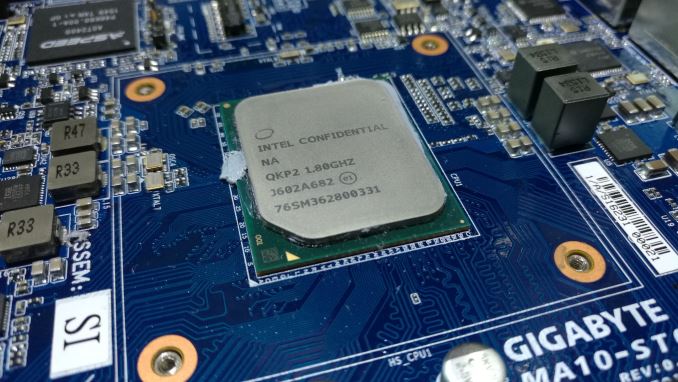


 Quote
Quote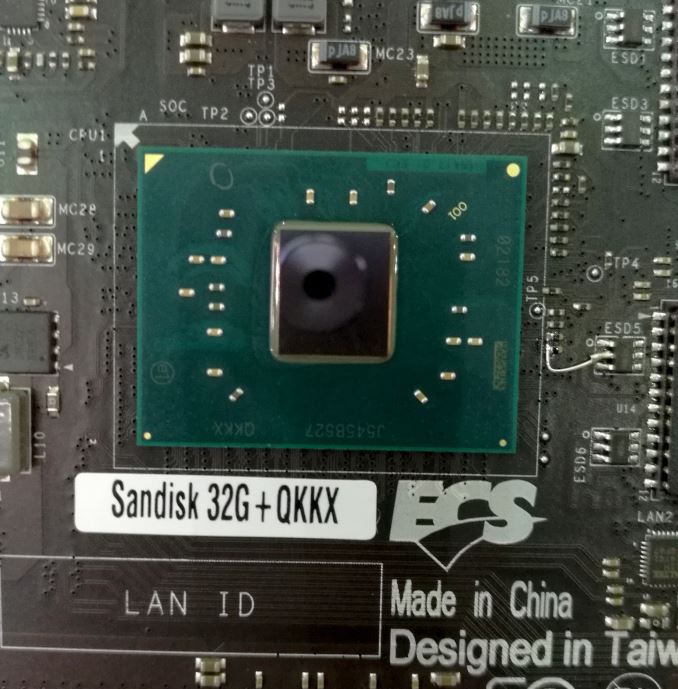
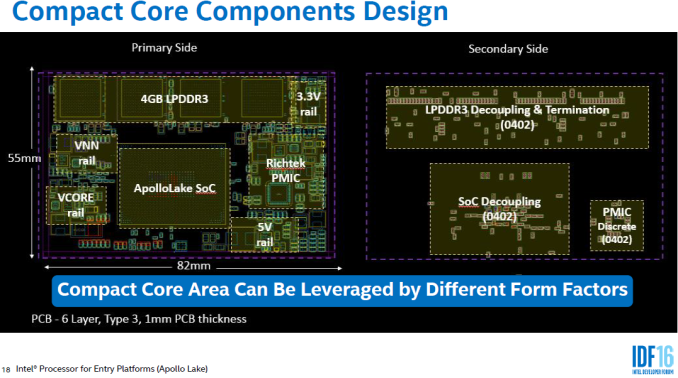

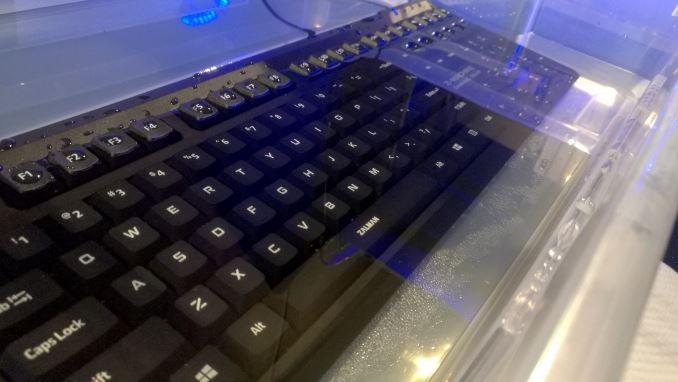
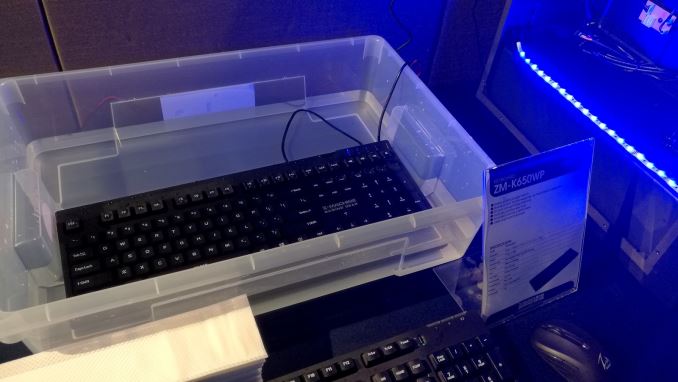
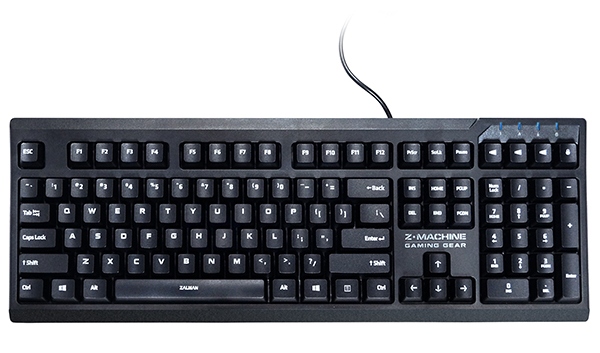
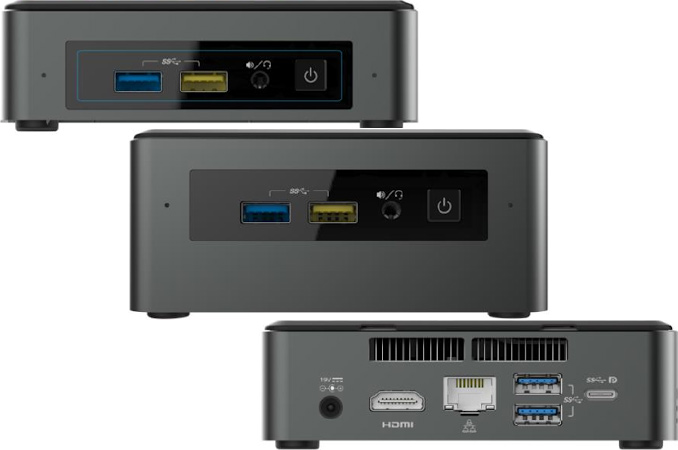

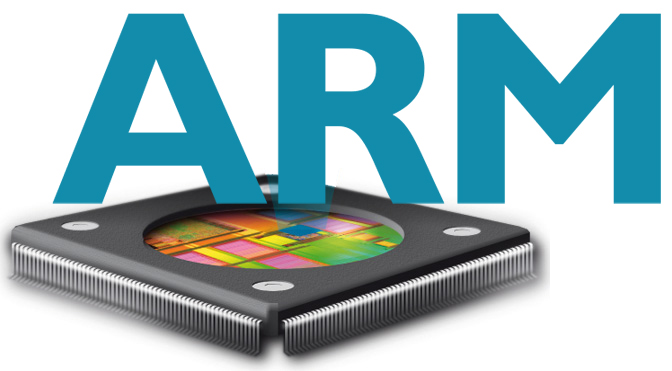
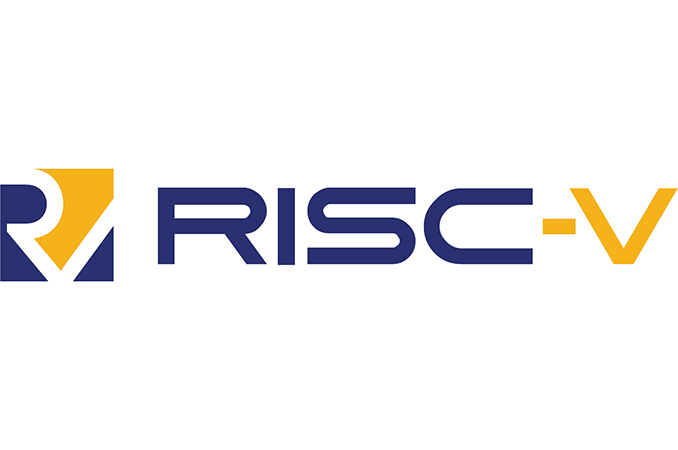
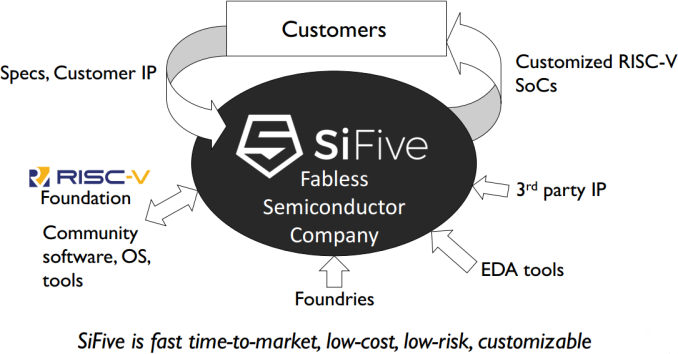
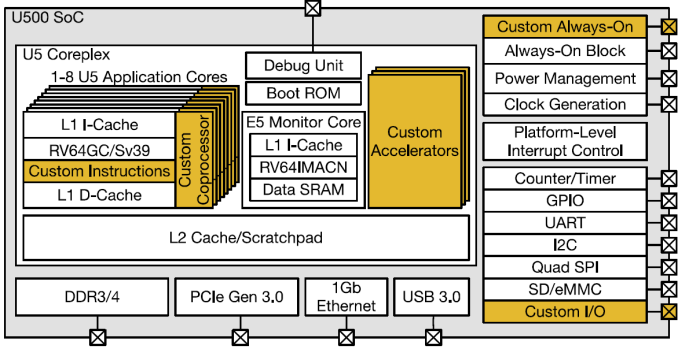

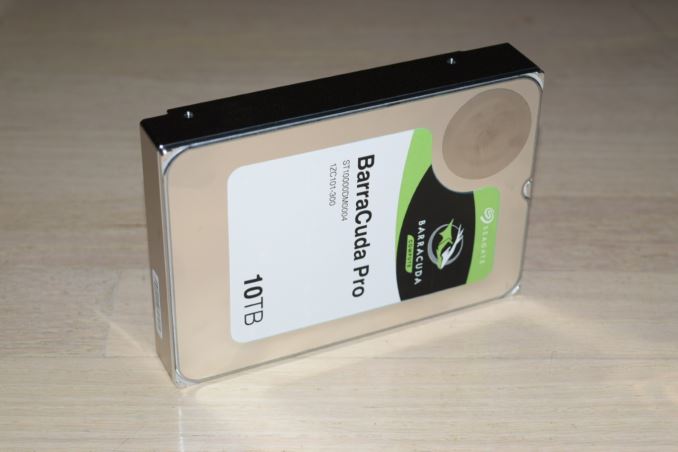
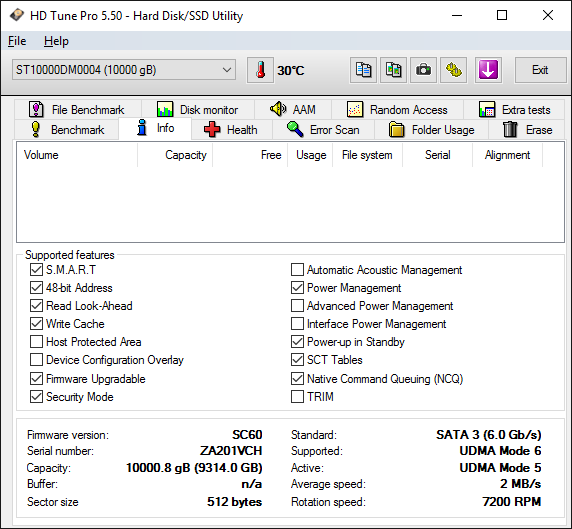
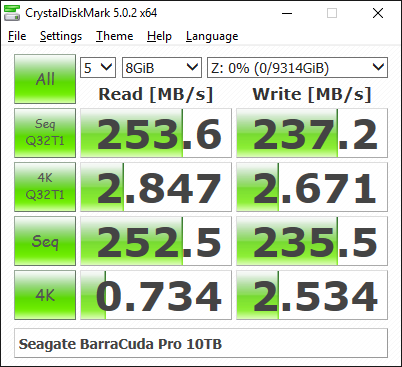
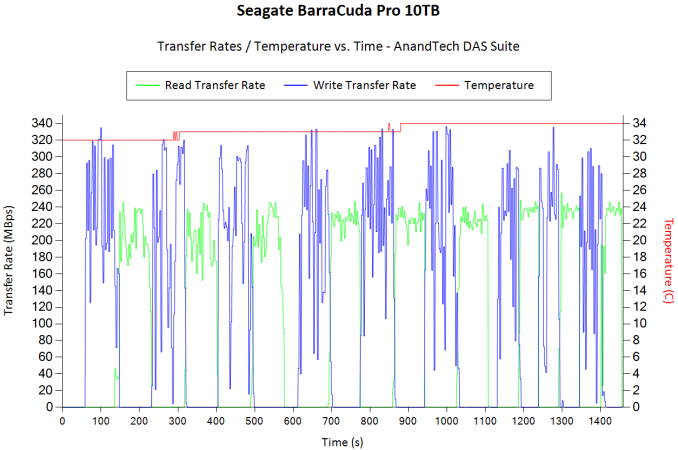
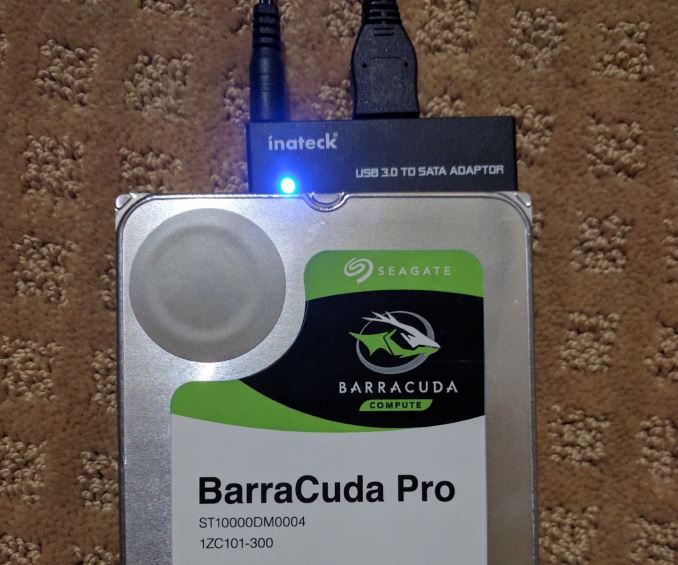
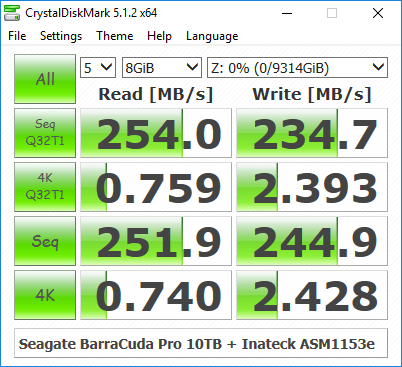
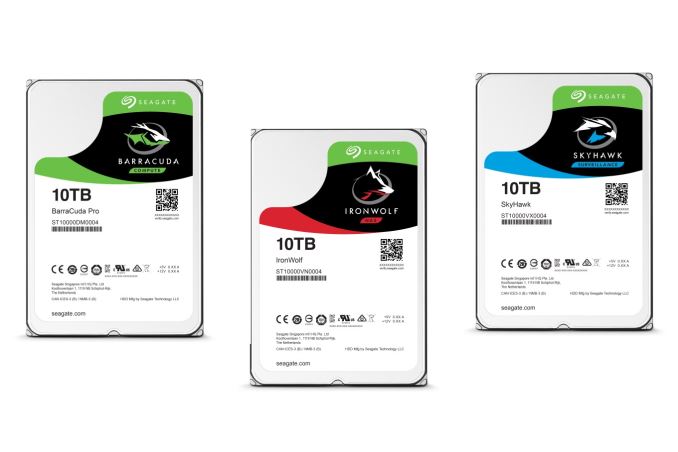
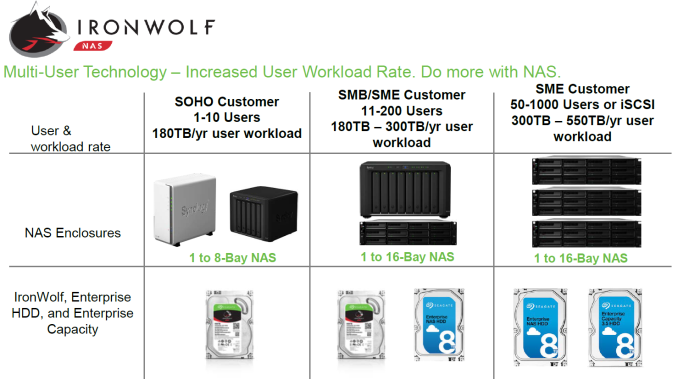




















Bookmarks